Biography of William Morris 1834-1896
In or before 1827 [his father] William Morris (age 29) and [his mother] Emma Shelton (age 22) were married.
Life of William Morris. William Morris, the eldest son and third child of William Morris (age 36) and Emma Shelton, was born at Elm House, Clay Hill, Walthamstow, on the 24th of March, 1834. His ancestry was on neither side in any way remarkable, and family records in the undistinguished middle class, whether commercial or professional, to which both his parents belonged, are generally scanty in amount and do not go far back. Such fact's as have been preserved may be briefly set down, without laying any stress on what is known or what is unknown in the history of the family.
On 24 Mar 1834 William Morris was born to William Morris (age 36) and Emma Shelton (age 30) at Elm House, Clay Hill.
From 1844 Edward Coley Burne-Jones 1st Baronet (age 10) attended King Edward VI Grammar School. From 1848 to 1852 Edward Coley Burne-Jones 1st Baronet (age 18) attended Birmingham School of Art after which he studied theology at Exeter College, Oxford University where he became a friend of William Morris (age 9), where, together with a group of friends they became known as the Birmingham Set who formed a society "The Brotherhood".
In 1847 [his father] William Morris (age 49) died.
Life of William Morris. Jun 1852. At the beginning of June, 1852, Morris (age 18) went up to Oxford, and passed the matriculation examination at Exeter. This was with the view of going into residence after the Long Vacation. But the college was then so full that his entry had to be deferred till the Lent term of 1853. He returned to Mr. Guy's meanwhile, and read with him for six months more, going with him for the Long Vacation to Alphington, in Devonshire, and returning to Walthamstow for the remainder of the year. At the examination in the Hall of Exeter there had sat next him another boy who had come up for the same purpose from King Edward's Grammar School, Birmingham, and was destined to be his most intimate and lifelong friend, Edward Burne-Jones (age 18).
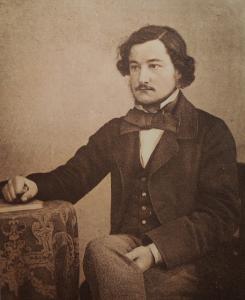 1857. Unknown Photographer. Photograph of William Morris (age 22).
1857. Unknown Photographer. Photograph of William Morris (age 22).
Letters of Dante Gabriel Rossetti. In Feb 1857 Dante Gabriel Rossetti (age 28) wrote to William Bell Scott (age 46):
Two young men, projectors of the "Oxford and Cambridge Magazine," have recently come up to town from Oxford, and are now very intimate friends of mine. Their names are Morris (age 22) and Jones (age 23). They have turned artists instead of taking up any other career to which the university generally leads, and both are men of real genius. Jones's designs are marvels of finish and imaginative detail, unequalled by anything unless perhaps Albert Durer's finest works' (W. B. Scott, Memoirs, ii. 37).
The Diary of George Price Boyce 1855-1857. 29 Jun 1857. Rossetti (age 29) and his friend Morris (age 23) (of 17 Red Lion Square), called on me in Buckingham St. and had tea. R. told me he was sure it was a man of the name of Sandys (age 28) who had done the caricature.
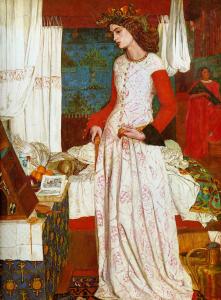 1858. William Morris (age 23). "La belle Iseult", sometimes referred to as "Queen Guinevere", is Morris' only surviving easel painting, now in the Tate Gallery. The model [his future wife] Jane Morris nee Burden (age 18), his future wife.
1858. William Morris (age 23). "La belle Iseult", sometimes referred to as "Queen Guinevere", is Morris' only surviving easel painting, now in the Tate Gallery. The model [his future wife] Jane Morris nee Burden (age 18), his future wife.
On 26 Apr 1859 William Morris (age 25) and Jane Morris nee Burden (age 19) were married at St Michael at the Northgate Church.
After 26 Apr 1859 William Morris (age 25) and [his wife] Jane Morris nee Burden (age 19) moved to the Red House.
Memorials of Edward Burne-Jones 1860. A few days before this we had been telling each other riddles, and one of us asked, "Who killed his brother Cain?" Morris (age 26) instantly fell into the trap and shouted, "Abel, of course!" amidst a peal of laughter from us all. Afterwards he thought it very funny himself, so on his return from the wedding we were not surprised to learn that he had amused the company at breakfast by trying the trick on some one else. "I asked the parson" - he told us triumphantly - "I asked him 'Who killed his brother Abel?' and when of course he said 'Cain,' I said 'Hah! I knew you'd say that - every one says it.'" And we laughed again, more than before.
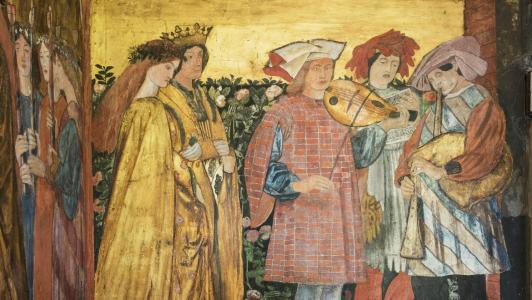 Memorials of Edward Burne-Jones 1860. A little later and we were with the Morrises (age 26) in their new house at Upton, and the time we spent together there was one to swear by, if human happiness were doubted.
Memorials of Edward Burne-Jones 1860. A little later and we were with the Morrises (age 26) in their new house at Upton, and the time we spent together there was one to swear by, if human happiness were doubted.
First was the arrival at Abbey Wood Station, a country place in those days, where a thin fresh air full of sweet smells met us as we walked down the platform, and outside was the wagonette sent from Red House to meet us; then a pull up the hill and a swinging drive of three miles of winding road on the higher land until, passing "Hog's Hole" on the left, we stopped at our friends' gate. I think Morris (age 26) must have brought us down from town himself, for I can see the tall figure of a girl standing alone in the porch to receive us.
It was not a large house, as I have said, but purpose and proportion had been so skilfully observed in its design as to arrange for all reasonable demands and leave an impression of ample space everywhere. It stood facing a little west of north, but the longest line of the building had a sunny frontage of west by south, and beneath its windows stretched a green bowling alley where the men used to play when work was over. For it was by no means on a holiday that Edward had come down, nor only to enjoy the company of his friend again, but that they might consult together about the decoration of the house, of which much is said in the Notes from which I have so often quoted.
The house was strongly built of red brick, and red tiled: the porches were deep and the plan of the house was two sides of a quadrangle. In the angle was a covered well. As we talked of decorating it plans grew apace. We fixed upon a romance for the drawing-room, a great favourite of ours called Sir Degrevaunt. I designed seven pictures from that poem, of which I painted three that summer and autumn in tempera. We schemed also subjects from Troy for the hall, and a great ship carrying Greek heroes for a larger space in the hall, but these remained only as schemes, none were designed except the ship. The great settle from Red lion Square, with the three painted shutters above the scat, was put up at the end of the drawing-room, and there was a ladder to its top and a parapet round it, and a little door above, in the wall behind it, that led into the roof. There at Christmas time it was intended that minstrels should play and sing. I began a picture from the Niebelungen Lied on the inside of one of the shutters of this settle, and Morris painted in tempera a hanging below the Degrevaunt pictures, of bushy trees and parrots and labels on which he wrote the motto he adopted for his life, 'If I can.' He worked hard at this and the room began to look very beautiful."
On one of his visits to Red House Rossetti (age 32) found many of these labels still blank, waiting for the words "If I can," and in his reckless way instantly filled them with another motto, "As I can't." When Morris saw this pleasantry, Edward said, "it would have puzzled the discriminator of words to know which of those two was most eloquent in violent English."
Memorials of Edward Burne-Jones 1860. Charles Faulkner (age 27) came down a couple of days after we did, and helped to paint patterns on walls and ceilings, and played bowls in the alley, and in intervals between work joined in triangular bear-fights in the drawing-room. Once, in the middle of a scrimmage that had surged up the steps into the "Minstrels' Gallery" he suddenly leapt clear over the parapet into the middle of the floor with an astounding noise; another time he stored windfallen apples in the gallery and defended himself with them against all comers until a too well-delivered apple gave Morris (age 26) a black eye; and then, remembering that Morris had promised to give away one of his sisters at her marriage a day or two afterwards, Edward and Faulkner left him no peace from their anticipations of the discredit his appearance would bring upon the ceremony.
1861. The Census records William Morris (age 26), [his wife] Jane Morris nee Burden (age 21), Algernon Charles Swinburne (age 23), Visitor, four servants and [his daughter] Jane Alicia Morris at Red House.
Around 1861 [his daughter] Jane Alicia Morris was born to William Morris (age 26) and [his wife] Jane Morris nee Burden (age 21).
On 25 Mar 1862 [his daughter] Mary "May" Morris was born to William Morris (age 28) and [his wife] Jane Morris nee Burden (age 22) at the Red House. She was baptised 30 May 1862 at Christ Church, Bexleyheath.
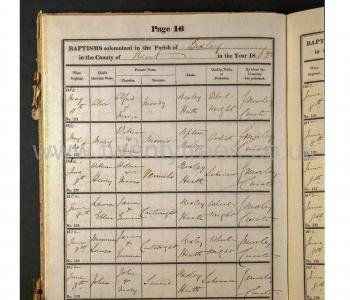
 1870. George Frederick Watts (age 52). Portrait of William Morris (age 35).
1870. George Frederick Watts (age 52). Portrait of William Morris (age 35).
1871. The census records William Morris (age 36), [his wife] Jane Morris nee Burden (age 31), Elizabeth Burden, sister-in-law, [his daughter] Jane Alicia Morris (age 10), [his daughter] Mary "May" Morris (age 8) and three servants living at 21 Queen Square, Bloomsbury.
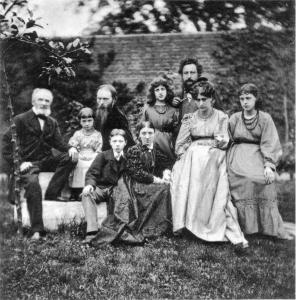 1874. Frederick Hollyer (age 35). Photograph of the Burne-Jones and Morris families including William Morris (age 39), [his wife] Jane Morris nee Burden (age 34), Edward Coley Burne-Jones 1st Baronet (age 40) and Georgiana Macdonald Lady Burne-Jones (age 33).
1874. Frederick Hollyer (age 35). Photograph of the Burne-Jones and Morris families including William Morris (age 39), [his wife] Jane Morris nee Burden (age 34), Edward Coley Burne-Jones 1st Baronet (age 40) and Georgiana Macdonald Lady Burne-Jones (age 33).
 Around 1885. William Blake Richmond (age 42). Portrait of William Morris (age 50).
Around 1885. William Blake Richmond (age 42). Portrait of William Morris (age 50).
 Around 1887. Frederick Hollyer (age 48). Photograph of William Morris (age 52).
Around 1887. Frederick Hollyer (age 48). Photograph of William Morris (age 52).
On 14 Jun 1890 [his son-in-law] Henry Halliday Sparling (age 30) and [his daughter] Mary "May" Morris (age 28) were married. She the daughter of William Morris (age 56) and Jane Morris nee Burden (age 50).
On 08 Dec 1894 [his mother] Emma Shelton (age 90) died.
On 03 Oct 1896 William Morris (age 62) died.
On 26 Jan 1914 [his former wife] Jane Morris nee Burden (age 74) died at 5 Brock Street, Bath. She was buried at St George's Church, Kelmscott [Map].
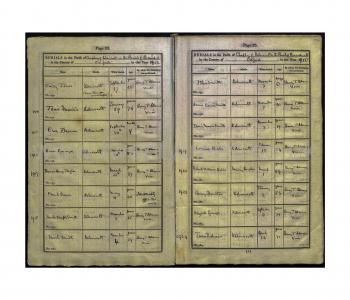
Life of William Morris. Some time before his death Mr. Morris had bought a nomination to Marlborough College for his son [William Morris]. The school had been recently founded "in a healthy and central position," to quote the terms of its prospectus," and conveniently accessible from all parts of England, being only twelve miles from Swindon, which is to be the great point of junction of the chief lines of railway in the kingdom." It was at all events in the centre of one of the most beautiful and romantic parts of England, in a neighbourhood full of history, and still fuller of prehistoric records. A childhood on the skirts of Epping Forest was fitly followed by a boyhood on the edge of Savernake. It is not easy to over-estimate the influence of these surroundings on the development of a sensitive and romantic nature, or their share in fostering that passionate love of earth and her beauty which remained a controlling and sustaining force throughout his life.
GrandFather: Unamed Morris
Father: William Morris
Great x 1 Grandfather: Charles Stanley
GrandMother: Elizabeth Stanley
Great x 1 Grandfather: John Shelton
GrandFather: Joseph Shelton
Mother: Emma Shelton